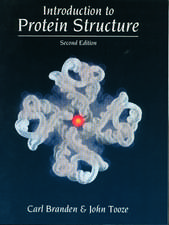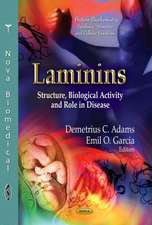Plant signaling: Understanding the molecular crosstalk
Editat de Khalid Rehman Hakeem, Reiaz Ul Rehman, Inayatullah Tahiren Limba Engleză Paperback – 23 aug 2016
| Toate formatele și edițiile | Preț | Express |
|---|---|---|
| Paperback (1) | 952.09 lei 6-8 săpt. | |
| Springer India – 23 aug 2016 | 952.09 lei 6-8 săpt. | |
| Hardback (1) | 959.67 lei 6-8 săpt. | |
| Springer India – 12 noi 2013 | 959.67 lei 6-8 săpt. |
Preț: 952.09 lei
Preț vechi: 1161.08 lei
-18% Nou
Puncte Express: 1428
Preț estimativ în valută:
182.20€ • 189.07$ • 152.29£
182.20€ • 189.07$ • 152.29£
Carte tipărită la comandă
Livrare economică 18 martie-01 aprilie
Preluare comenzi: 021 569.72.76
Specificații
ISBN-13: 9788132234791
ISBN-10: 8132234790
Pagini: 365
Ilustrații: X, 355 p. 56 illus., 42 illus. in color.
Dimensiuni: 178 x 254 x 19 mm
Greutate: 0.64 kg
Ediția:Softcover reprint of the original 1st ed. 2014
Editura: Springer India
Colecția Springer
Locul publicării:New Delhi, India
ISBN-10: 8132234790
Pagini: 365
Ilustrații: X, 355 p. 56 illus., 42 illus. in color.
Dimensiuni: 178 x 254 x 19 mm
Greutate: 0.64 kg
Ediția:Softcover reprint of the original 1st ed. 2014
Editura: Springer India
Colecția Springer
Locul publicării:New Delhi, India
Cuprins
1. Plant signaling: response to reactive oxygen species.- 2. SNARE proteins as signalling elements.- 3. Plant Rab GTPases in membrane trafficking and signaling.- 4."PtdIns4P and PtdIns(4,5)P2 as signalling phosphoinositides involved in tip growth ".- 5. Sugar signaling in plant growth and development.- 6. Nitrogen regulation and signalling in plants.- 7. "Phosphorus deficiency in plants: responses, adaptive mechanisms and signaling".- 8. Reactive oxygen species-associated mechanism of acclamatory stress tolerance, signaling and redox-regulated gene expression in plants.- 9. Cyclic nucleotide gated channels-Essential signalling components in plants for fertilization and immunity responses.- 10. Signaling in response to cold stress.- 11. Cell Signaling during Drought and Salt Stress.- 12. Heat signaling and stress responses in photosynthesis.- 13. Senescence: Regulation and Signaling.- 14. Molecular builders of cell walls of Lignocellulosic feedstock: a source for biofuels.- 15. Recent Trends in Jasmonate Signaling Pathway.- 16. Salicylic acid signaling.- 17. Ethylene signaling in plants- introspection.- 18. Plant, Mycorrhizal fungi and bacterial network.- 19. Self-Incompatibility patterns and signal transduction.- 20. Plant Disease Resistance genes: From perception to signal transduction.
Notă biografică
Dr. Hakeem is currently working as Post doc Research Scientist at Faculty of Forestry, Universiti Putra Malaysia, Serdang, Selangor, Malaysia. Dr. Khalid has so far edited more than seven books with Springer and other European publishers. He has also to his credit more than 30 publications in various national and international journals.
Dr. Rehman is currently working as an Assistant Professor, Department of Bioresources, University of Kashmir, Srinagar, India. Recipient of several fellowships at both national and international level, particularly, the award of the Marie Curie IIF project (MC-IIF-FP7-219339). He has worked on agronomical, physiological and biochemical aspects of mineral nutrition in mustard, which is relevant to economical aspect in terms of crop productivity. He managed the in vitro regeneration and propagation of several important medicinal plants followed by the genetic transformation of medicinal plants with stress related genes. He has to his credit one published book and 22 publications in various national and international journals.
Dr. Tahir is currently working as the Professor, Department of Botany, University of Kashmir, Srinagar, India. He has done extensive work pertaining to physiological studies on buckwheats in Kashmir. He has also been actively perusing the research on flower senescence and post harvest physiology of the ornamentals. He has published more than 60 papers in various national and international journals.
Dr. Rehman is currently working as an Assistant Professor, Department of Bioresources, University of Kashmir, Srinagar, India. Recipient of several fellowships at both national and international level, particularly, the award of the Marie Curie IIF project (MC-IIF-FP7-219339). He has worked on agronomical, physiological and biochemical aspects of mineral nutrition in mustard, which is relevant to economical aspect in terms of crop productivity. He managed the in vitro regeneration and propagation of several important medicinal plants followed by the genetic transformation of medicinal plants with stress related genes. He has to his credit one published book and 22 publications in various national and international journals.
Dr. Tahir is currently working as the Professor, Department of Botany, University of Kashmir, Srinagar, India. He has done extensive work pertaining to physiological studies on buckwheats in Kashmir. He has also been actively perusing the research on flower senescence and post harvest physiology of the ornamentals. He has published more than 60 papers in various national and international journals.
Textul de pe ultima copertă
Plant signalling has emerged as an integrated field which has become indispensable in recent times to study any biological process. Over the last decade, an enormous amount of information has been generated in this field and the advances in information technology gave birth to bioinformatics which has helped greatly in managing the galaxy of information. It is now possible to view the different information’s in a systems biology approach which has unravelled the association/ new processes and thus helped us enormously in understanding of the biological processes. The present book is an attempt at understanding the plant signalling processes with different perspectives. Even though the plants are sessile but there exists a tremendous interconnected network of perception at morphological, physiological and molecular levels. The impact of the surrounding environment in terms of abiotic and biotic stresses is significant in terms of its survival, adaptation and productivity for the human welfare. The plants possess a wide array of processes at the organ, tissue and cellular levels which are governed by a plethora of molecules. The molecules govern individual processes and these exists a cross talk between them to form a complex network of processes. The book tries to envision how different processes are operating at different points in the life cycle of the plant
Caracteristici
The present book helps in understanding the complex communication patterns in plants The book explains in detail how plants respond and adapt to various biotic and abiotic stress factors The book is essentially a comprehensive summary of the vast information provided by various experts from across the world













